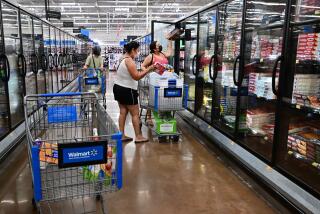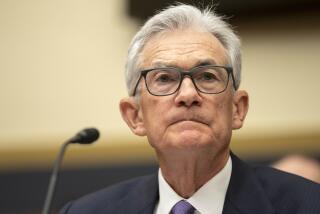Fed chief Ben Bernanke faces decision on inflation
With the well-being of millions of Americans and the U.S. economy at a pivotal point, Federal Reserve Chairman Ben S. Bernanke faces a crucial decision — and he faces it almost alone on a world stage.
At issue is whether it’s time to begin putting on the financial brakes to avoid a potentially dangerous surge in inflation or instead keep stimulus policies in place to help keep the still-vulnerable recovery moving ahead.
If the Fed gets the decision wrong, the consequences could be grave and far-reaching.
Bernanke, who has expressed repeated concern about the health of the recovery and has pressed for continued stimulus, finds himself increasingly isolated in a global economy where fears of inflation are rising.
Higher prices already are straining China and other developing countries. Investors pushed the price of gold, a hedge against inflation, above $1,500 an ounce for the first time last week. Earlier in the month, the European Central Bank shifted course and raised interest rates.
The Fed will take up the issue when its top officials begin a two-day meeting Tuesday, and Bernanke will defend the central bank’s strategy in his first-ever news conference the next day.
The debate over whether to continue easy money policies to stimulate the economy or instead turn toward tighter money goes beyond economists. American consumers are also feeling the bite of higher prices for gasoline and food, adding a political note to the issue.
“I never went over $50 [to fill up] my car and now I’m going over $60,” grumbled John Hoyt, a retired healthcare manager who lives in a suburb of Orlando, Fla.
Gas prices nationally have jumped about 40% since last fall, to more than $3.80 a gallon nationwide — more than $4.20 in California.
That’s not all, Hoyt’s food bills are higher too, in part because transportation costs have risen. Two weeks ago, he said, the cost of a liter-sized bottle of soda at his local market shot up 12%. “Did your salary go up 12% last year?” he asked.
Critics of the Fed have blamed the central bank’s loose monetary policies, in part, for the surge in commodity prices and recent rise in global inflation, a contention that Bernanke and others at the Fed have vigorously denied. But even some of Bernanke’s own colleagues have spoken out against what they see as too much of a good thing.
At least for the moment, the Fed is likely to keep short-term interest rates at near zero and leave open the credit-flowing spigot to support the economy, continuing on a move to buy $600 billion of U.S. Treasury notes through June.
But belying the Fed’s typically bland policy statement — and the carefully rehearsed answers that are likely to follow in Bernanke’s news session — there is growing restlessness.
For months, Bernanke and his supporters have downplayed the recent increase in U.S. inflation, arguing that overall consumer price gains reflected spikes in oil and other commodities that were unlikely to last. In the past, fuel price surges often had been followed by sharp drop-offs some months later, most recently in 2008.
“An accommodative monetary policy continues to be appropriate because unemployment remains elevated,” said Janet Yellen, the Fed’s vice chair, in a speech this month.
The Fed has a dual mandate to control inflation and maximize employment.
With U.S. unemployment at nearly 9% and faced with troubling ripple effects from problems in Japan and Europe, the Fed has continued to buy billions of dollars of U.S. bonds in a bid to hold down long-term interest rates and spur economic growth.
Fed officials prefer to look at so-called core inflation, which excludes volatile energy and food prices, and this measure has been considerably more subdued.
In March, core inflation was up 1.2% from a year earlier, less than the Fed’s informal target of 2%. Even so, the core rate has climbed steadily since dropping to 0.6% in December. And the consumer price index for all goods and services rose to 2.7% in March, about double the annual pace in December.
Many experts, including some Fed regional bankers who sit with Bernanke in the policy meetings, warn that the U.S. may be heading for soaring inflation down the road, especially given its huge national debt.
One voting member, Richard Fisher, president of the Fed bank in Dallas, recently warned that the U.S. economy could face the same hyperinflation as did Germany’s Weimar Republic after World War I, when a wheelbarrow full of marks couldn’t buy a newspaper.
Outside economists are questioning the Fed’s assumption that energy and food prices will settle back down soon without further feeding into other goods and services such as transportation and material costs.
“The Fed is in a very difficult dilemma,” said Bernard Baumohl, chief global economist at the Economic Outlook Group.
The U.S. economy is doing better, especially on the job front, he said, but it is still at a subpar performance. At the same time, inflation is creeping higher, and the forces behind the food and energy price surges don’t look temporary to Baumohl.
The political upheavals in the Middle East and North Africa that have shaken oil markets won’t be subsiding any time soon — and may in fact widen and give rise to even higher oil prices.
As for grains and other foods, Baumohl said, the increase in part reflects the growing incomes and middle class in China, India and other emerging countries — something that’s likely to continue for years to come.
“All these are assumptions,” said Lynn Reaser, chief economist for Point Loma Nazarene University and past president of the National Assn. for Business Economics. “I think there’s a bigger risk that inflation isn’t as bearish as Fed officials believe.”
In her association’s April survey, 35% of respondents in industry and trade groups reported increases in prices, more than double the previous two quarters. That reflects higher material costs, in part from soaring oil prices, and greater demand as the global economy continues to recover.
What’s more, 41% of the respondents said they expected their firms to raise prices in the third quarter.
Labor costs are also rising at many firms as they add more hours and employees, though at the moment, there’s little indication that wages of American workers are heading higher.
With millions unemployed and many more stuck in part-time jobs, economists don’t see much pressure for broad increases in wages — and without that, some say, there’s little risk of surging inflation.
What’s more, for some categories of goods, such as electronics, new technologies and improved manufacturing processes are continuing to keep prices in check.
Still, Reaser noted that Fed policy typically works with a considerable lag, whereas inflation can turn up quickly if commodity prices keep rising.
“To the extent people begin to expect higher prices, they’ll be less willing to wait for price reductions and they’ll be demanding larger wage increases down the road,” she said.
The Fed’s latest economic projections see continued restrained inflation both in the near term and longer range.
But private surveys suggest U.S. consumers foresee a gloomier picture. Many of them expect inflation to climb 5% or more this year, a sharp increase from just a few months ago.







